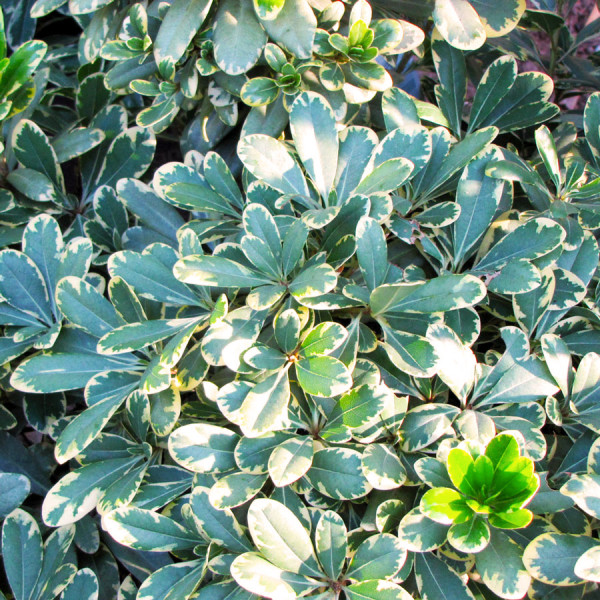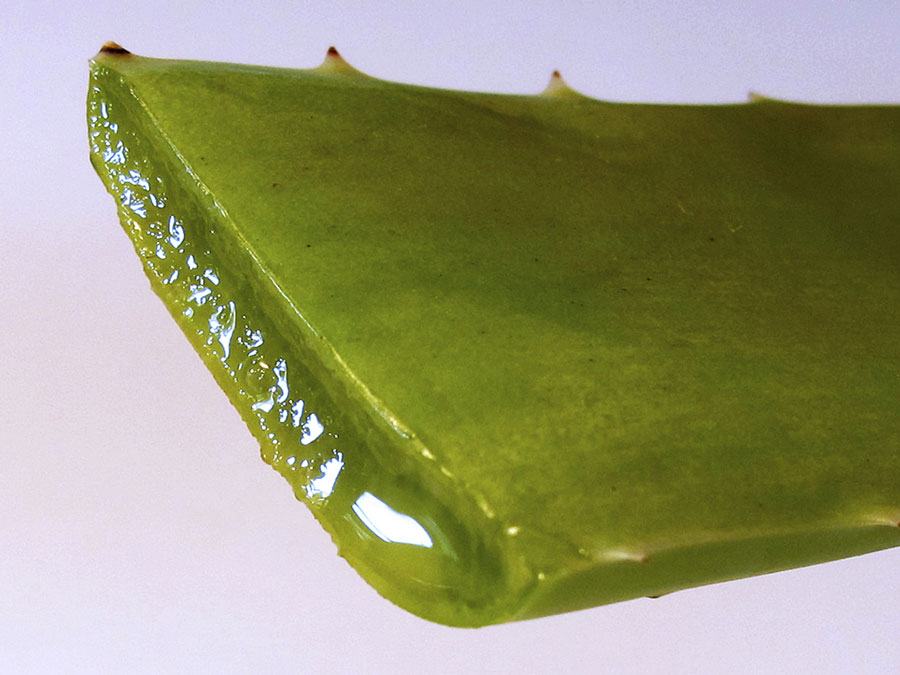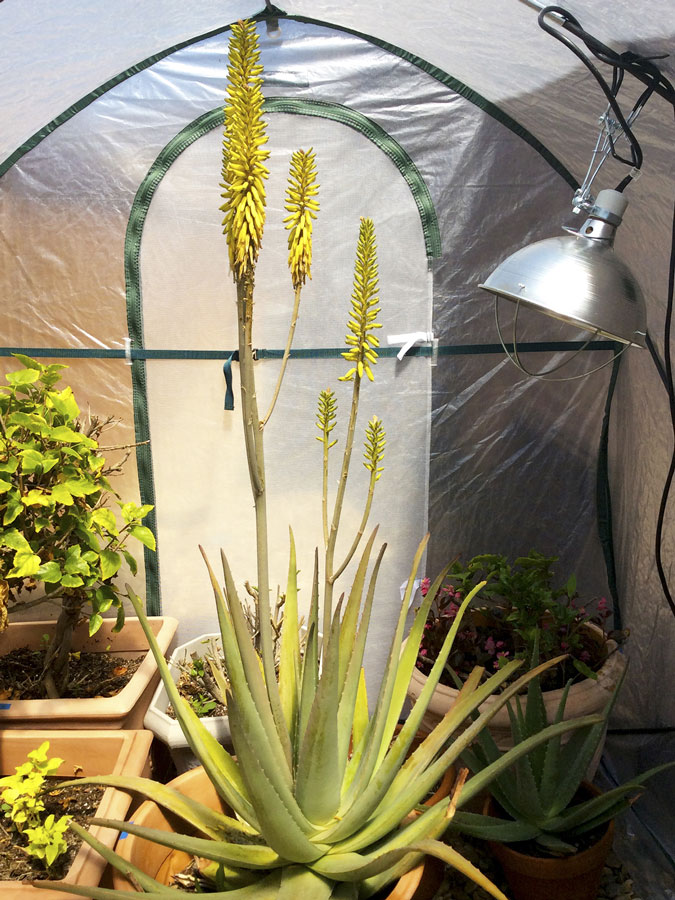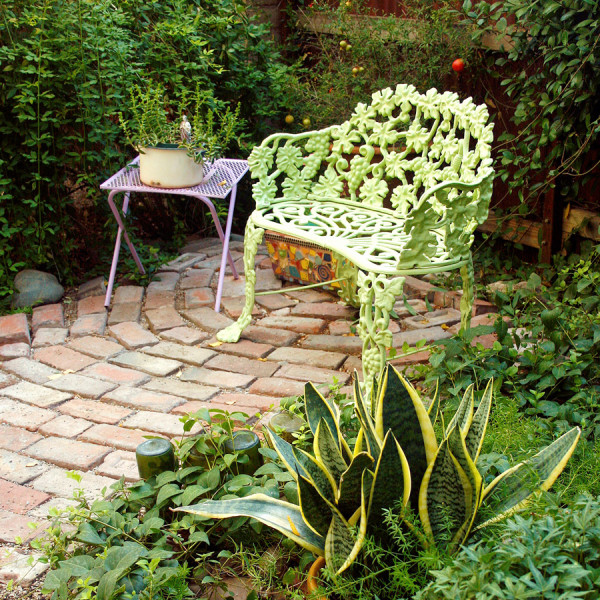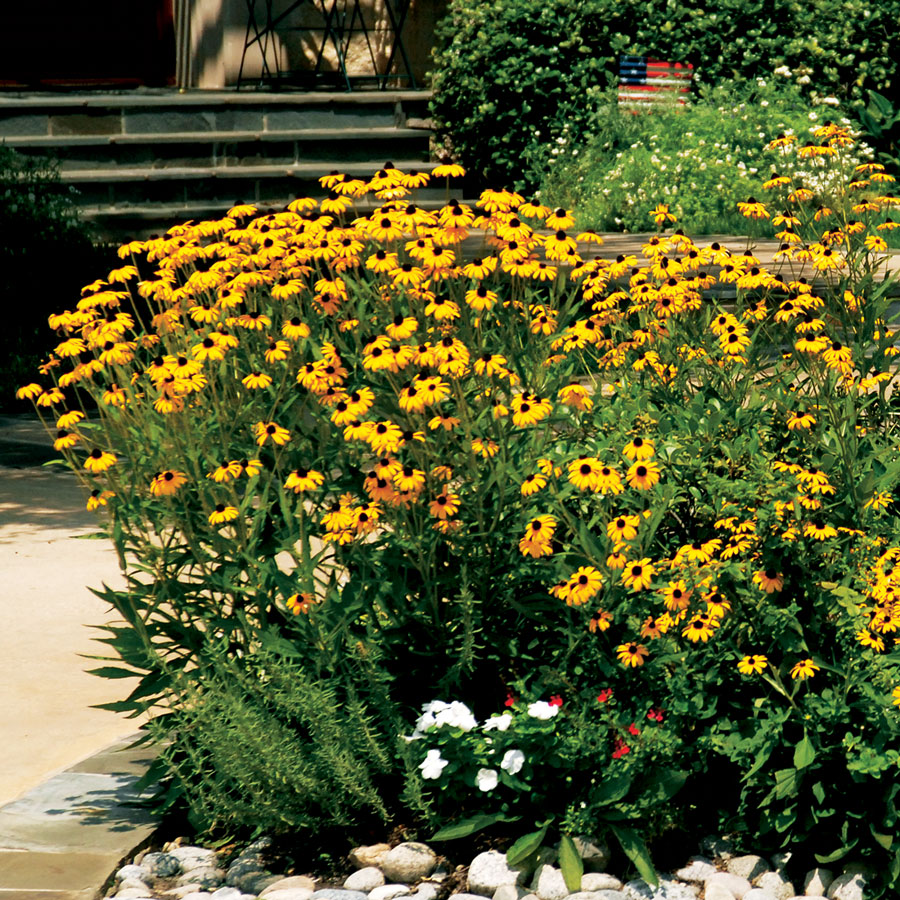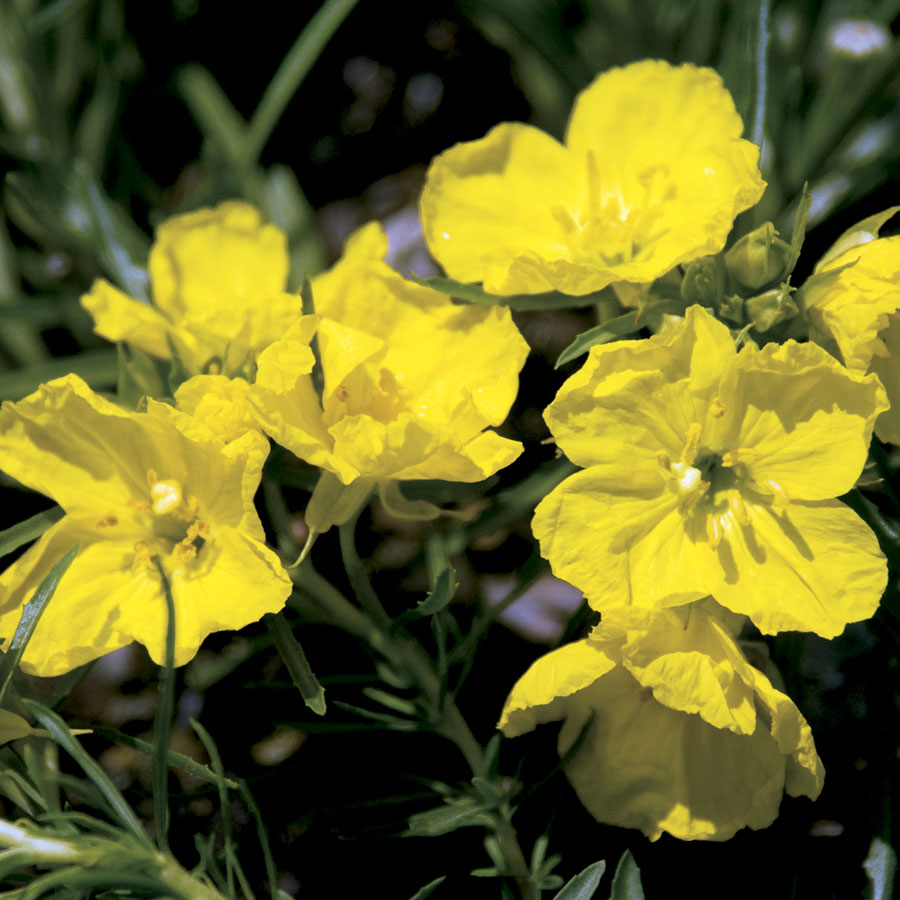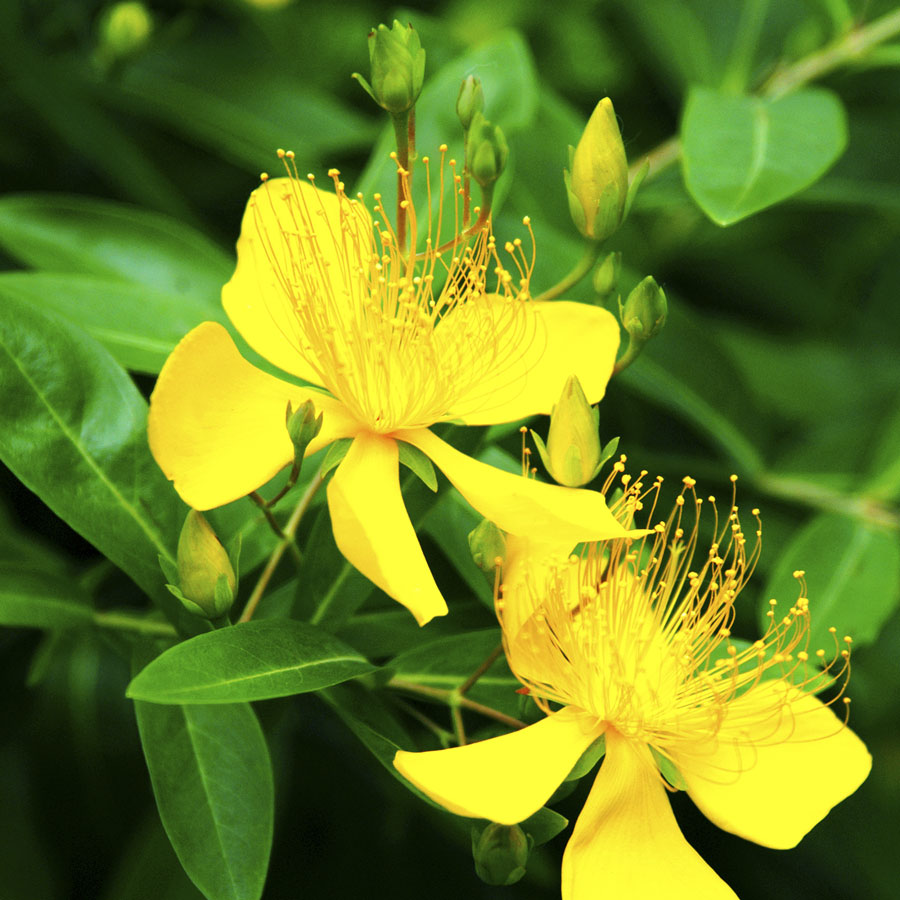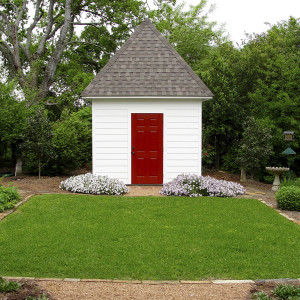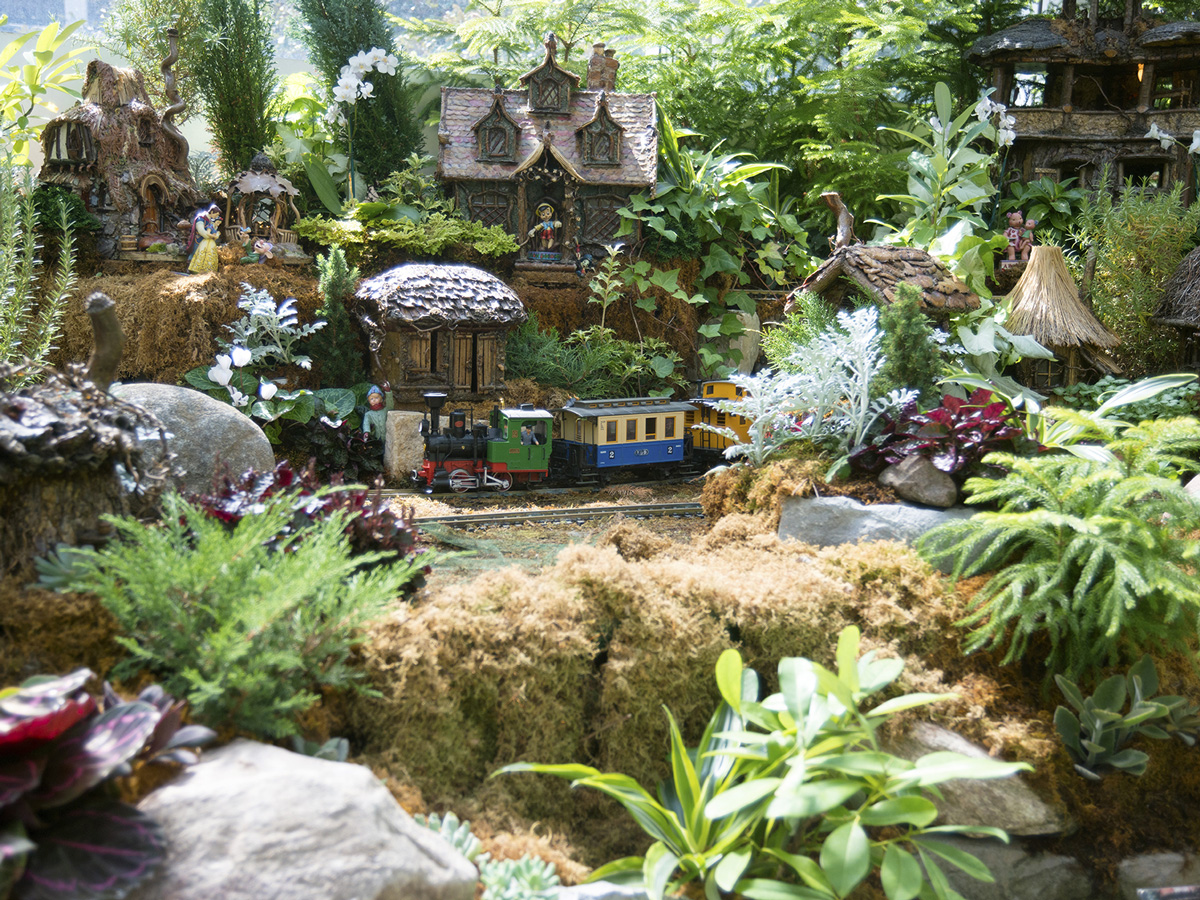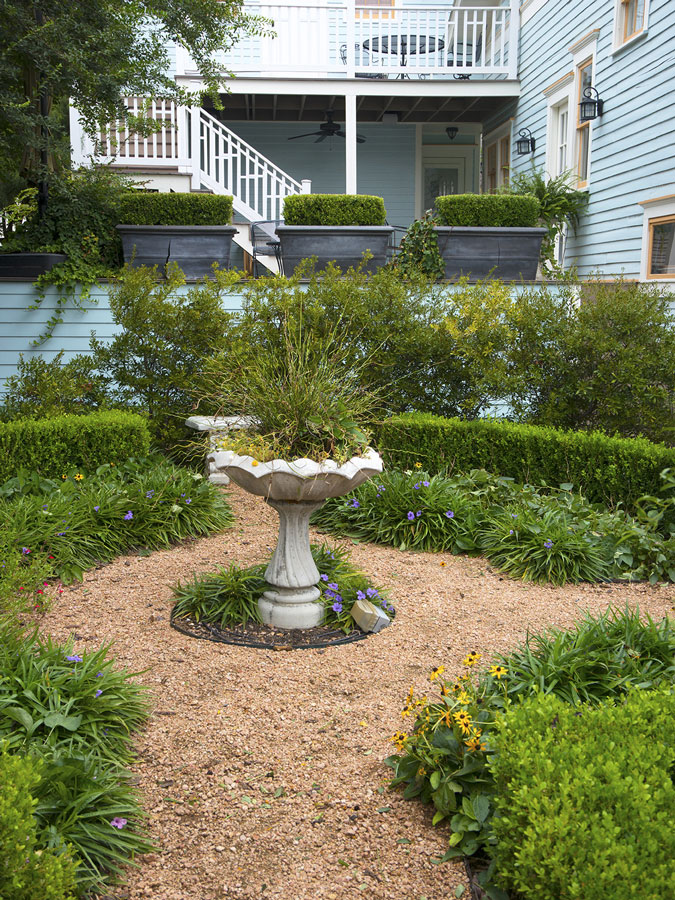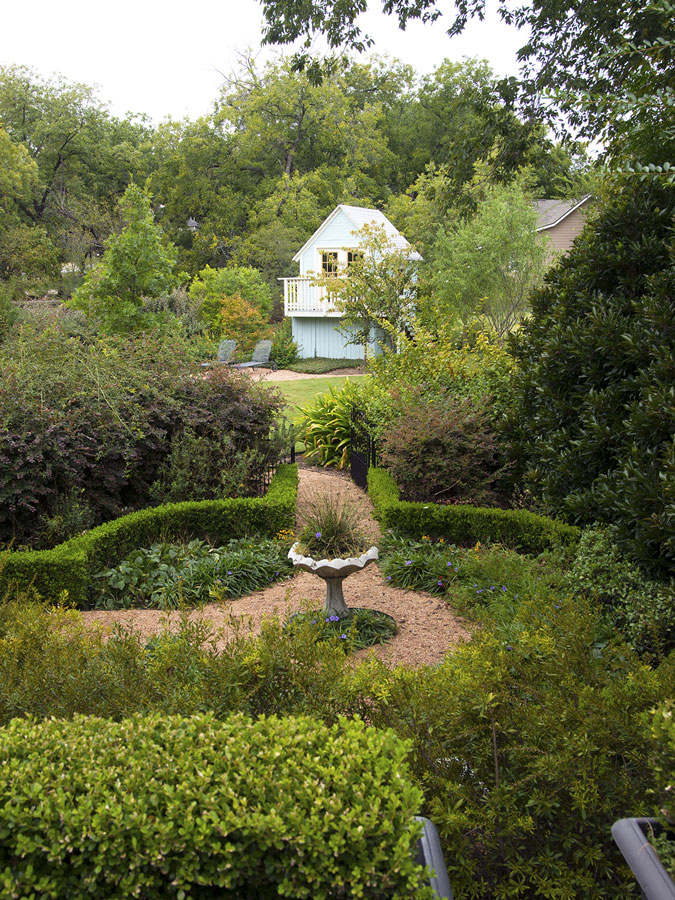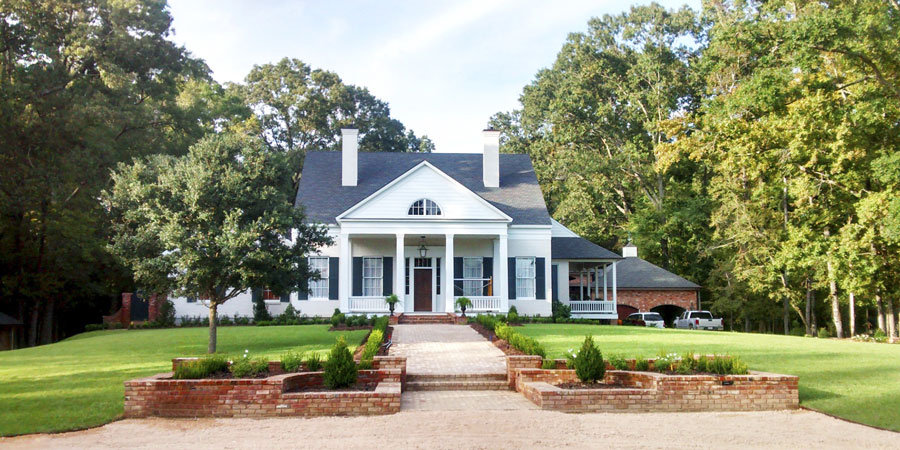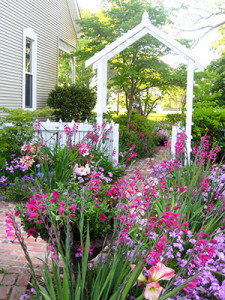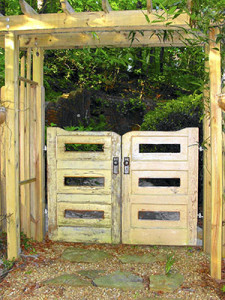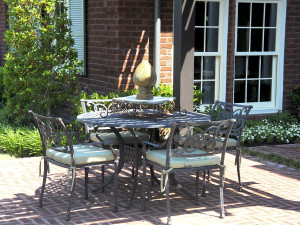I’VE BEEN OVERSEEDING my Texas lawn with ryegrass for 38 years. I sow it in September, and we admire it clear into May. It does things for our landscape that I simply couldn’t accomplish without it. Here are some quick facts to help you determine if it’s a good match for your needs.
• All ryegrass is annual in Texas. It is a cool-season grass that should be planted in September or early October. It will grow while bermuda and St. Augustine are brown in the winter. It will die out as temperatures climb above 90 in May.
• “Perennial” rye seed costs more, but it’s worth every penny. It’s finer-bladed, so it makes a more attractive lawngrass. It requires half as many mowings as annual ryegrass. And remember, that it’s not going to be truly “perennial” here in Texas (except perhaps in the northern Panhandle and Davis Mountains). Your local nursery can order perennial rye seed if they don’t normally stock it. Their suppliers have it.
• Don’t make the mistake of overseeding with Texas’ other cool-season turfgrass, tall fescue. It is truly perennial and will be impossible to eliminate from your permanent grass once you have it started. Either you have an all-fescue lawn, or you should have no fescue at all.
• Sow rye seed at 4 to 8 pounds per 1,000 square feet. To avoid missed areas, sow the seed at half rate going east to west and the other half going north to south.
• Commercial landscapers will scalp turf before overseeding in September. You don’t have to do that, but do mow before sowing.
• Have someone work with you to hold up a large piece of cardboard or other baffle along the edges of your lawn to keep the seeds from landing in beds or on gravel paths, flagstone walks, etc.
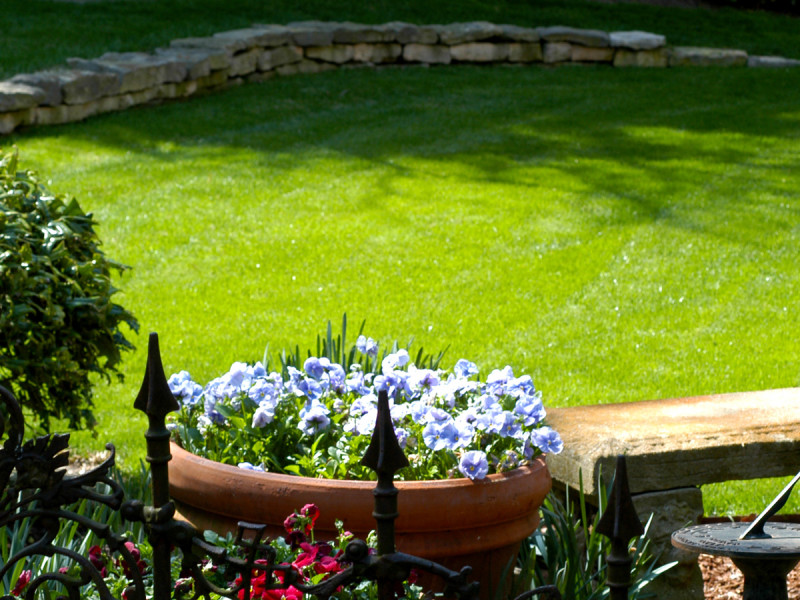
In combination with cool-season annuals and bulbs, an overseeded lawn belies the notion that things are dead for many months in winter.
• Water deeply immediately after you sow the seed and at 4-day intervals for the first couple of weeks until the grass is up and growing. Then water as you normally would for your permanent lawngrass. If you are in water conservation mode and are reluctant to plant ryegrass as a result, you can sow it as described and water it one time. From that point on, you take the chance that fall and winter rains will keep it going. The rye in my lawn in the lead photo of this story was watered the day it was planted and not one additional time all fall and winter. Natural rains in North Central Texas kept it growing vigorously.
• Because ryegrass is a cool-season grass, it should be fed in November and again in February with a high-nitrogen food with half or more of the nitrogen in slow-release form.
• Mow the rye at the same height you use for your permanent turf. It will do just fine at whatever height you choose.
• Ryegrass will start to disappear as weather gets hot in late April (South Texas) or early May (North Texas). For about a week the lawn may look a little unusual. Professionals call it “transition” as the warm-season grass takes hold once again. It has never been a major worry for me.
VARIEGATED PLANTS ARE ALWAYS POPULAR because they are different. Planted in a shady spot, variegated foliage adds a nice bright spot of color and contrast as well. Dark green plants will fade into the background in a shade garden, but leaves with white spots or margins draw attention.
Here are my five favorite variegated plants for shade.
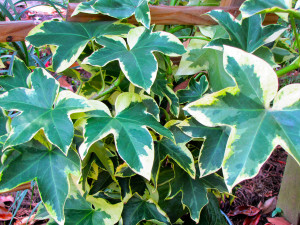
Popular Fatshedera has maple- or sweetgum-shaped leaves with creamy white borders. It is hardy into Zone 7, happiest in light shade. Photo © Mary Wilhite.
• Fatshedera is a gorgeous, manmade hybrid cross between Fatsia (false aralia) and Hedera (ivy). Large, thick, maple-shaped leaves of green are rimmed in creamy white. The long, loose stems need support from a trellis to show the plant to best advantage. Fatshedera grows slowly, but it is very long lived once it gets established.
• Variegated Solomon’s seal (Polygonatum odoratum ‘variegatum’) is a rewarding plant in many ways. A hardy perennial with lovely, arching stems about 24 inches tall, it spreads well, but is not aggressive. Bright green leaves are edged in white, and in spring small, white, bell-shaped flowers hang from the bottom edges of the stems. This plant likes moist, well-drained soil, but is not bothered by insects or disease.
• Variegated Japanese sedge (Carex oshimensis ‘Evergold’) creates a stunning border in a partially shaded bed. An arching clump of pale golden grass-like leaves with green margins grows 12 inches tall and 18 inches wide. The foliage stays up all year, but the plant looks best if cut to the ground in early spring to sprout up fresh, new growth. Like all sedges, Evergold is not bothered by deer.
• Variegated pittosporum. A new dwarf pittosporum sports creamy white margins on gray-green leaves to create a ghostly appearance in the garden. ‘Mojo’ is a member of the Southern Living plant collection, well suited for the heat and humidity of southern gardens. This evergreen shrub grows only 3 feet tall and wide, perfect for today’s smaller gardens. It is also very tolerant of salt, making it ideal for growing along the coast.
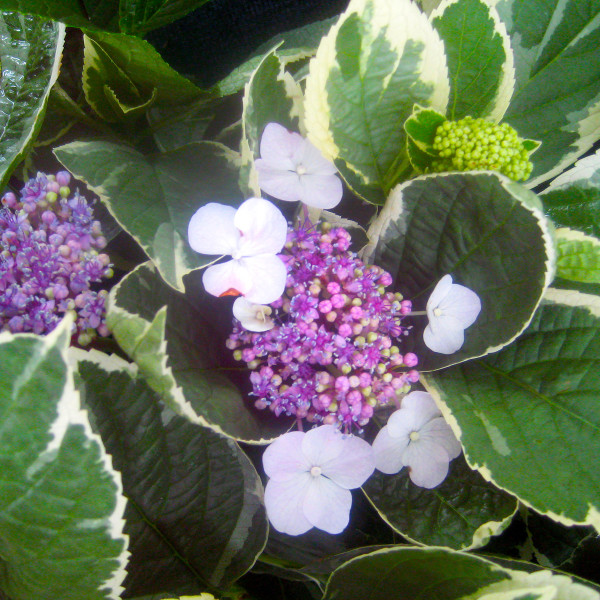
Like all hydrangeas, variegated hydrangeas like afternoon shade to protect leaves from burning. Photo © Mary Wilhite.
• Variegated hydrangea. For those of us living in the eastern part of the state, hydrangeas are staples in the shade garden. Variegated hydrangea (Hydrangea macrophylla ‘Variegata’) adds the charm of white-rimmed leaves to highlight the pink or blue lacecap flowers in summer. As with all hydrangeas, morning sun helps the plants develop flowers while afternoon shade protects the leaves.
Try one or more of these plants in your shade garden to lighten up the dim space. If you see a branch with green leaves among the variegation, cut it out right away.
As an herb enthusiast I value and grow plants useful for food, fragrance, and medicine. Among the dozens I grow in my garden is Aloe vera, a desert succulent. Sometimes called “true aloe,” “medicinal aloe,” or “burn plant,” Aloe vera is valued for its clear gelatinous sap, which is an effective first aid for skin damage, especially burns. This is why cooks will sometimes keep an aloe plant in the kitchen window for quick access.
The light green, stemless, sword-shaped leaves of Aloe vera are 6 to 18 inches long, depending on the age of the plant. The plant forms an ever-expanding whorl of toothed leaves. Mature plants may send up a showy 2-foot flower stalk with tubular-shaped, drooping orange flowers.

A rock garden favorite (where temperatures won’t drop much below 30°F), aloes bear their blooms on tall stalks in colors ranging from yellow and white to orange and red. Photo © Neil Sperry.
Aloes generally prefer full sun and relatively low water conditions throughout the growing season. When frost threatens, bring them indoors or provide cover. They may survive brief periods of cold, but sustained temperatures below freezing will definitely kill them. If you live in an area where snow or ice is an occasional part of winter, you should grow aloes in containers so they can be brought indoors or into the greenhouse.
During the winter, resist the urge to water or fertilize container-grown aloes as you would other houseplants. Keep the soil on the dry side, and watch out for mealy bugs, which tend to attack plants grown indoors. In spring move the aloes outdoors, and resume regular watering and light fertilization.
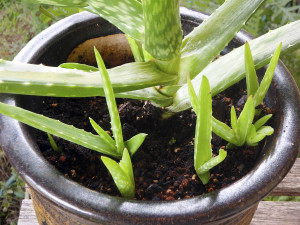
Young plants that grow at the base of a mother plant are often called “pups.” Given their own pots and not much care, these pups will grow into full-size plants. Photo © Ann McCormick.
Aloe vera propagates very easily by producing offshoots (sometimes called pups) close to the base of the parent plant. These can be easily removed with a sharp knife and planted in another container. If left with the parent plant, the ever-increasing offshoots will crowd the pot to the point it can be hard to see where one plant starts and another ends. For this reason, those who want to grow a large specimen plant should quickly remove offshoots.
If you enjoy the easy care of Aloe vera, you might want to try growing a few of its relatives.
• Tiger aloe (Aloe variegata) is more compact than Aloe vera, growing to only a foot high. Its dark green leaves are shorter and broader than Aloe vera and have silver streaks in chevron formations that give the leaves a tiger striping.
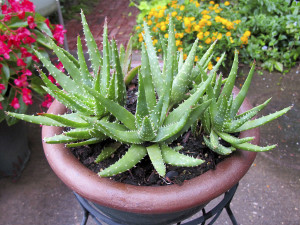
Dwarf aloes remain only a few inches in girth. They can be used as groundcovers in warm areas or picturesque patio plants where winters are cold. Photo © Carolyn Skei.
• Lace aloe (Aloe aristata) grows only 6 inches high but forms a wide head with up to 100 leaves or more. The leaves are thickly dotted and have a very thin, almost thread-like, tip, giving the appearance of a lacy texture. This is one of the few aloes that are cold tolerant; it has been known to survive in snowy conditions. Its flowers are orange-red.
• Short-leaved aloe (Aloe brevifolia) has stubby blue-grey leaves with toothed edges. The leaves may also have blunt spines along the back. The flower stalk produces dense clusters of drooping yellow flowers.
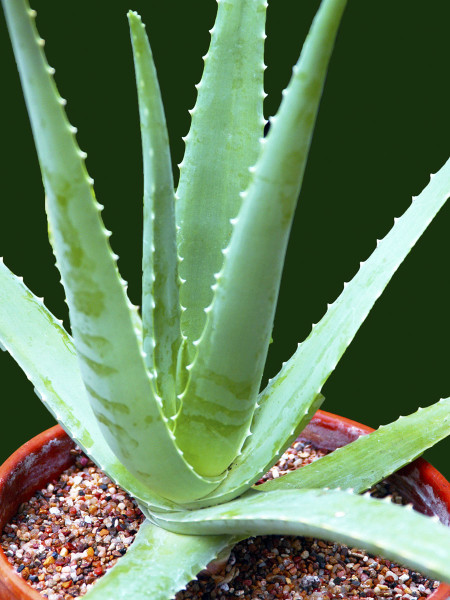
One of our most familiar succulents, Aloe vera thrives in Texas heat. The sword-shaped leaves are dramatic not just in the garden but in containers as well. Photo © Neil Sperry.
• Sunset aloe (Aloe dorotheae) has leaves that are medium green near the base but when grown in strong light will develop a rosy to bright red tint near the tips.
These are just a few of the more than 300 aloes available from cactus and succulent sources and even from places as exotic as eBay. (Tip: always search “aloe” in the singular, as eBay sellers almost always list plants individually.) Most aloes are native to hot, dry areas, making them easily adaptable to Texas, whether in containers in areas where it freezes or outdoors along the Gulf Coast. Do note, however, that some species of aloes grow to be quite large, tree-form succulents. Choose according to the space you have available for them.
Next time you’re on the lookout for something different to grow, try aloes.
CHECK OUT MORE ALOE PHOTOS FROM NEIL AND OTHERS:
The current trend in home decorating boasts vibrant interior colors including teal, tangerine and a throng of sunny yellows. But painted walls, doors, chairs, and various small decorative items have a place in gardens, too.
Besides accentuating the color scheme of garden flowers, paint brightens shady areas, and calls attention to specific parts of the garden. Paint adds year-round color, a perk in winter months when seasonal color has waned. And just as painted surfaces influence interior ambience, a pale pink picket fence or a vibrant Caribbean-red garden gate announces garden style.
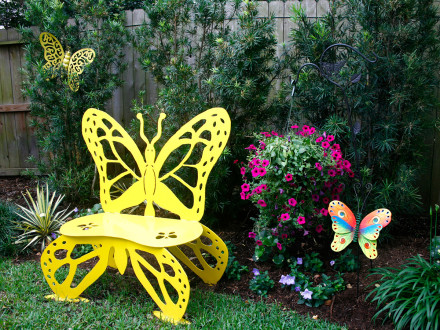
A repeat butterfly theme and bright colors heighten the excitement in an otherwise quiet corner of the yard.
Paint is useful for creating cohesion, as well. Items of unlike materials become garden unifiers when painted the same color. Likewise, a coat of paint erases the disparity between an old oak swing and a new pine table, instantly making them a matched set.
As if that’s not enough, a few brushstrokes of paint camouflage patches, dings and other imperfections and inconsistencies, including new pickets in a repaired fence.
Thinking big, starting small
Fortunately, manufacturing has kept pace with Mother Nature!
Paint is available in thousands of shades that match or complement most hues of flowers, foliage and other wonders of nature. Even so, if you are a color novice, you might want to start by freshening up a windowbox or stylizing a wheelbarrow before painting a wall or other major feature.
Often, small projects can be completed in an afternoon. Bins, barrels, buckets, chairs, gliders, gates, shelves and shutters, among other objects, welcome color transformations.
Creativity rules
Besides giving instant results, paint inspires creativity. Select a single bold color or mix and match various hues. Incorporate patterns and stripes. Use stencils or freehand skills to add dots, stars, foliage, or other designs.
Plain terracotta pots, for instance, take on a festive south-of-the-border look when decorated with red, blue, orange, and yellow horizontal stripes and folk-art motifs. Use chalk to rough out the design. Masking tape helps to maintain clean edges. For the most impact, display three pots together on a patio or at poolside. For summer color plant the pots with red geraniums or exotic-looking succulents.
Galvanized buckets welcome floral patterns set in a border around the rim. Galvanized watering cans invite a two-tone look. Create the look by painting the handle and spout blue: paint the body green.
Big color, big statement
Before adding a “WOW” factor to walls, fences, doors, and other large, permanently set garden features, buy a small test can of paint, apply it to a large piece of cardboard, and tack it up to observe how sunlight and shadow play on the hue.
Solid colors provide a backdrop and help to accentuate plants and other garden features. But when you want a wall or door to become a focal point, be creative with color, design and technique by layering colors, painting two-tone checkerboard borders around doors and windows, stippling texture onto surfaces, or stenciling foliage, flower and fruit motifs to walls. Remember to exaggerate scale so your masterpiece can be enjoyed from a distance.
Paint gives instant results both indoors and outdoors. Painted surfaces add interest, set themes and bring cohesion to gardens. Better still, by applying a new coat of paint next year, you can give an entirely different look to the garden.
I love what the phrase “as good as gold” implies. I especially like what it means for the garden. What other color can do quite as much for a planting as gold can? It’s a hue that goes well with any color scheme. I enjoy purple, blue and white flowers in my gardens, and I find the addition of gold in flowers or foliage is perfect to warm up cool colors. If your scheme includes red and orange, you can freely add gold to enhance it.
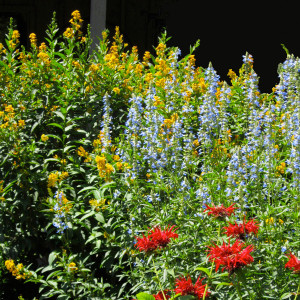
Cestrum grows tall, loves the heat, and adds a golden glow to the mixed bed. It’s paired here with bog sage and red bee balm. Photo © Sharon Lee Smith.
Keep in mind, gold is the most visible color to see from afar. Gold flowers fade less in the heat compared to other colors of flowers. In the fall, I love the way gold lights up my garden as the sun gets lower in the sky.
There are many perennials and flowering shrubs with gold or golden yellow blooms that are well worth planting. Let’s narrow the choices down to those with late summer or fall flowers.
• Cestrum ‘Orange Zest’ has proven to be a winner. Quite a large plant, we find it grows taller with each passing year, reaching 6 feet tall and almost as wide. It absolutely loves the heat and is “Texas tough.” Its tubular flowers attract hummingbirds and butterflies summer through fall.

Mexican mint marigold, a long-lived perennial, offers vivid flower clusters late in the season. Photo © Sharon Lee Smith.
• An herb with a lovely fall presence is Mexican mint marigold (Tagetes lucida). The taste is similar to French tarragon, making it useful in the kitchen as well as the garden. What I like best about this long-lived perennial (some of mine are over a decade old) is the appearance of bright, colorful flowers late in the season. The edible flowers look smashing as a garnish in salads or drinks, too.
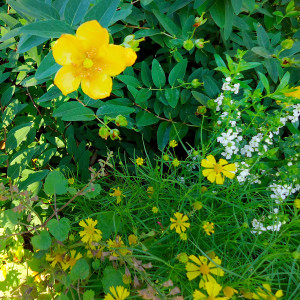
Golden St. John’s wort, Hypericum, is a reliably hardy shrub in much of Texas. The low-growing companion plant (foreground) is Helenium. Photo © Sharon Lee Smith.
• Graceful and natural in appearance, Hypericum ‘Sunburst’ looks marvelous as part of a partial-shade perennial planting. Semi-evergreen in winter, the shrub provides structure, and in summer the brightly colored blooms liven up your planting.
• Helenium ‘Dakota Gold’ is a native wildflower that reseeds itself freely. Diminutive in size, growing just 6 or 8 inches tall, it produces copious amounts of blossoms, giving each plant the appearance of a colorful little cushion. This Texas Superstar blooms summer and fall and is very tolerant of low water conditions.
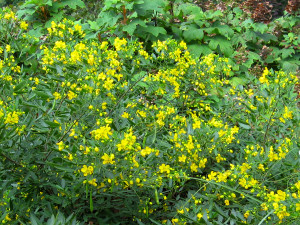
This large blossoming shrub is flowery senna (Cassia corymbosa). The golden blossoms are followed by picturesque pods. Photo © Neil Sperry.
• Cassia corymbosa, known commonly as flowery senna, is a late-blooming deciduous shrub worth noting. Once the blooming period has finished, the shrub sports peapods that take on a chartreuse tint. It makes quite a conversation piece. Morning sun and afternoon shade are ideal, and since this shrub covers 5 feet, allow enough space to accommodate it.
• The popular butterflybush (Buddleia davidii) comes in many colors. Not as common, Buddleia x weyeriana ‘Honeycomb’, a longer-lived perennial, grows very tall (6 to 7 feet). The yellow/gold flowers with orange centers are unique, and butterflies flock to them.
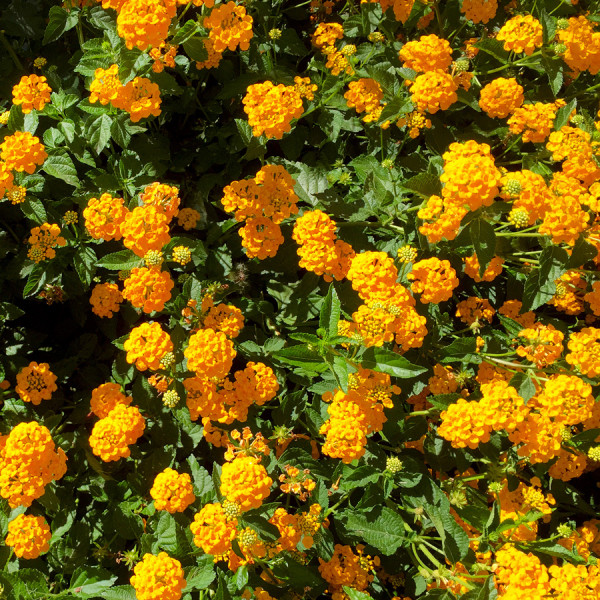
New Gold lantana is everyone’s go-to plant for a blanket of gold in the garden. Photo © Neil Sperry.
• I know everyone tires of lantana, but when the heat is on, it is hard to deny that Lantana ‘New Gold’ is one showy plant. It loves the sun, and the hotter the temperature gets, the better. As far as returning each year, this variety has a far better chance than most lantanas. The main thing to remember is that a single plant covers a wide area, so do not crowd it against other plants or they will disappear beneath.
Adding one of these later-season, gold-flowering plants into your color scheme will bring a touch of much-needed cheerfulness in late summer and fall. Most will provide longevity to your plantings as well.
August is a watershed month in the life of your pecan crop. Literally. If you let down on your management practices now, all your prior hard work may go for naught. Here are your critical tasks for the weeks close ahead.
• Water deeply as the soil dries out. Early summer rains across most of our state have caused pecans to develop large fruit. But the kernels haven’t filled out just yet, and that’s where August irrigation comes into play. Water travels through the outer portion of the husk to its far end, then it enters the kernels and causes them to expand within the now-enlarged husks. If things suddenly turn very dry, the kernels may not fill out completely. One good and deep soaking during August will probably be all that your trees will need. If it doesn’t rain, you can make up for it with a soaker hose or sprinkler.
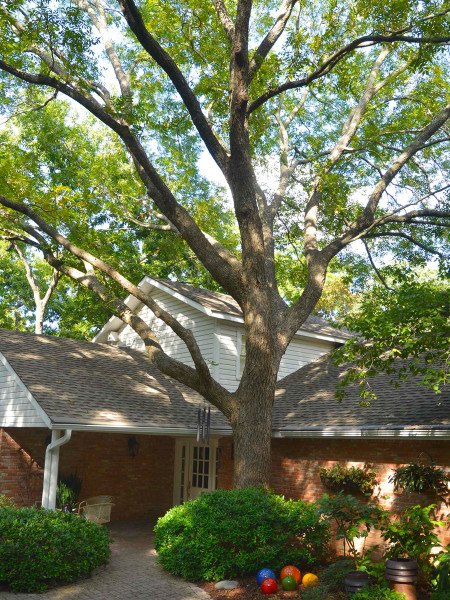
A pecan tree that was almost killed by the bulldozer operator when our house was built in 1977 now towers over it. The tree was 8 inches in trunk diameter then. It is more than 24 inches today.
• Hickory shuckworms. These larvae develop during August within the outer husks of the pecans. And, if you were just paying attention, that’s where the water is carried as it heads to fill out the kernels. If shuckworms tunnel around in the shucks, they’ll cut off the supply of water to the kernels, and you’ll end up with hollow pecans that fail to drop at the normal time in November. To stop shuckworm damage in pecans, spray with a labeled insecticide in the first and last weeks of August.
• Pecan weevils. If you have ever cracked a pecan open only to find a nasty little larva crawling around inside it, that was a pecan weevil. While they don’t do as much total damage as shuckworms, they’re certainly worth spraying. The good news is that the two shuckworm sprayings should also prevent pecan weevils.
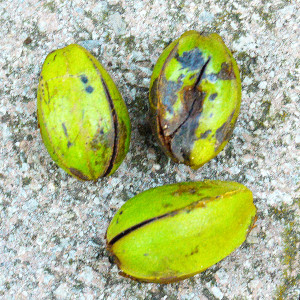
Pecan scab causes fruit to fall prematurely, also to develop black spots. Kernels will be black and watery.
• Pecan scab. If you have pecans falling from your trees now, they probably were infected with pecan scab during the wet weeks in May and June. It’s a fungal disease that can be helped by fungicidal sprayings made in spring and summer (too late for this year). For any future plantings, you can reduce the threat of pecan scab by choosing a variety that is suited to your local area. The Texas A&M fact sheet on pecans (see link at end of this article) will help you make the best selections.

This is squirrel damage to a live oak, but pecans will often face the same fate. Squirrels disfigure the trees, but they won’t kill them.
• Squirrel damage. These rodents came as factory equipment with our pecans. And for the most part, they do a good job of planting and replanting the state’s pecan forests. But their teeth grow continuously, and they must therefore also sharpen those teeth every day. If you see shards of pecan bark on the ground beneath your trees this time of the summer, you can rest assured that squirrels have been active directly overhead. You can also rest assured that that branch will die within a few weeks or months, and that it will eventually fall to the ground. It’s not a huge issue, and it’s pretty difficult to stop it. But at least you’ll know what is doing it.
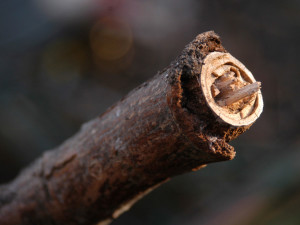
Twig girdler adult scores branches, then deposits her eggs. When the branch dies and falls, it looks like it’s been cut with a knife.
• Twig girdler. This large beetle has sharp mouthparts. She scores a branch the size of a broomstick or smaller by cutting around and around it in spirals. Then she deposits her eggs in the part out beyond the cut. Eventually that tip of the branch dies and falls to the ground, larvae still inside it. There is no spray for the adult beetles or the larvae, but you can reduce populations somewhat by picking up the fallen branches. This is not a huge long-term concern for pecans.
• Aphids. If you notice tiny droplets of what looks like rain falling from your pecans…. If you notice stickiness all over surfaces beneath your pecans…. If black sooty mold grows in that stickiness…. Congratulations! You have aphids in your pecans (and other shade trees). But unless you have power spray equipment that will reach to the tops of the trees, there isn’t much a home gardener can or should do. Just park somewhere else (like we do), and wash off the surfaces below.
• Webworms. Different types of these pests show up in spring and again in late August. They don’t kill the trees, but they certainly make them look terrible. Use a long-handled pole pruner to remove the webs 16 or 18 feet up in the trees. I clip them off when the webs are still small (a few inches in diameter). If you wait much longer, the webs will be several feet long, and pruning won’t be an option. At that point, just use the blade of the pole pruner to tear the webs open so birds can feast on the larvae. I guess you could spray for them. (Include one drop of liquid dishwashing detergent per gallon of mixed spray to help it break through the surface tension of the web.) However, again you’d have to have power equipment. It’s just easier to prune out as many as you can reach.
Texas A&M has some outstanding fact sheets on the various fruit and nut crops for Texas. Here is the one they offer for pecans. Scroll down to see information on varieties for each part of Texas.
Note from Neil: This is Greg Grant’s third article in a series for us on Landscape Principles. The first two terrific articles appeared in our March/April and May/June 2015 print editions of GARDENS magazine. We’re delighted to offer “reprints” of those two articles at the bottom of this installment for our growing e-audience.

Low-growing hedges and medium-height trees in the front yard create the human scale needed for this home to nestle serenely into a backdrop of towering pines. Photo © Greg Grant.
One of the most common problems homeowners experience when tackling their own landscape designs involves the design principle known as scale or proportion. Scale involves the relationship of all visual parts of the landscape to the home and surroundings. It’s more difficult to explain than other landscape principles, but try I will.
A common notion with amateur gardeners is that landscaping is all about decorating the outside of a home – scattering yard jewelry about, if you will. Wrong. Proper landscaping is about making a home or garden fit into its site, physically and aesthetically. Homes should comfortably fit into their surroundings like feet in good shoes or baby birds in a swaddling nest.
One concept of scale that is important to grasp right out of the gate is that your landscape includes more than just what you own. Your landscape also includes what is known as the “borrowed landscape,” which is anything that you can see from your landscape. In other words the views, surrounding buildings, neighbors’ yards, horizons, streets, trees, fences, and forests are all part of the landscape that you have to deal with visually. So, like it or not, aesthetically you own everything you can see! If you don’t want to “own it” or deal with it artistically, you will need to screen it from your view – with an appropriate-sized screen, of course.

Modern urban homes are often very large, coming close to filling their lots. You’ll still want the impact of shade trees and larger shrubs, but choosing the right plants that won’t grow too large will be more challenging than ever. Photo © Neil Sperry.
Without a doubt, the most common downfall in most home landscapes is landscaping on too small a scale for the structures and sites. There are two common reasons for this. First of all, it’s human nature to look only at what’s in front of you or what you own. It’s also human nature to look at the trees instead of the forest. When landscaping a home, or anything for that matter, it’s absolutely essential to look at the big picture, not just the individual pieces in front of you. Think of it like this. Most people reading an article or book are focusing on, at best, a few words at a time. But in the landscape thought process, they need to think about the words, the paragraph, the book, the chair, and the entire room.
Another reason most homeowners landscape on too small a scale involves both effort and cost. Naturally, the more blood, sweat, tears, and cash you put into something, the bigger it seems. My wonderful junior high art teacher, Peggy Chevelier, at Judson Junior High in Longview, taught me a technique to deal with this problem. I’ll never forget it or her. Everyday we’d each leave our project and walk to the back of the room to view it. Oh my, how different things look when you aren’t staring them in the face!
I learned this lesson again, in a hard way, later. One of the first landscapes I ever installed involved an immense amount of work; it was literally years in the making. But when I finally finished it and took the time to view it from afar, much of what I had spent effort on didn’t visually exist! All that time and effort wasted – because I looked at the parts instead of the whole. I had to start over and make all the beds three times the size they were.
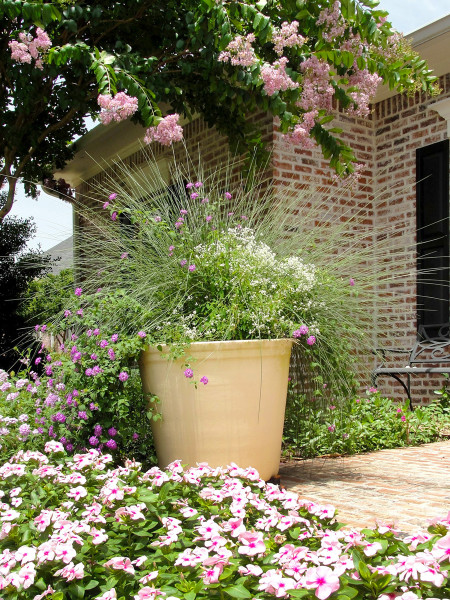
A large container spills plants lavishly, all in scale with a towering crape myrtle and overflowing bed of vincas. Photo © Greg Grant.
The sizes of beds, furniture, pots, art, and other hard materials in a landscape are much easier to understand than the plants are because they stay the same size. They don’t grow. It’s beyond extremely important that gardeners, designers, and homeowners know the ultimate size of every plant that they put in. Plants all start out small and they all grow larger, some extremely large. We all know people who planted small shrubs that grew large under windows or who planted small trees that tried to grow into giants under power lines. And the opposite is just as common – making the mistake of planting small shrubs and small trees around giant homes in giant spaces.
Let me leave you with the elementary version of my view of scale. Small homes in small spaces need smaller beds and smaller plants, while larger homes in large spaces need larger beds and larger plants. That’s oversimplified, but it’s true. The size of everything you use and every space you create in your landscape should tie the size of humans to the size of their home to the size of their surroundings.
So don’t think just about the color of a plant you purchase or whether it’s one of your favorites or not. Think, too, about how big it’s going to get, how many you need, whether they fit into the space you are putting them into, and whether they fit into the overall big picture. More times than not, you’ll find you are wasting your time and money on small, unrelated “decorations” that don’t amount to a hill of beans in the big picture. Save your time and your money by sizing things up!
PUT YOUR FINGER ON THE SCALE:
CLICK TO SEE MORE PHOTOS!
Think of it as another room of your house. A room where friends and family gather. A room where happy sounds originate. A room where you can wind down from the stresses of being a human in your other life.
Early patios were drab little slabs of plain gray concrete. You stepped off the shag carpet and out onto that slab. You looked around for a moment, thought about how uninspiring it was, and then you headed back to the shag.
Patios now are night-and-day different, often with lavish designs that inspire us to get outdoors and have fun. Today’s patios rock, and they’ve become embedded in our everyday lives.
Picking the Plants
Plants play a big part in making patios work. But not all plants function in the same ways. You need to pick and choose wisely. Maybe these suggestions will help get you started.
• Bordering plants. These need to be low, so they don’t break your line of sight out into the landscape. We’re looking for groundcovers and very low shrubs for much of the planting, with medium and tall shrubs off to the sides as a visual frame.
• Shading trees. Unless your patio faces east, you’re going to be looking for some kind of shade from the late afternoon sun. Trees are an obvious choice. But trees can damage patio surfaces if their roots grow too large, so stick with small types near the patio (within 5 to 8 feet). Larger species need to be given still more root room.

Trees and large shrubs assure privacy in this part of the Sperry landscape. Groundcovers and containers complete the frame.
• Shrubs and vines for privacy. If you have a fence, use a vine to soften its harsh lines. Vines take up almost no horizontal land space, so your yard is left for you to enjoy. If you don’t have a fence, and if you still want a little privacy, choose shrubs that will grow tall enough to break the views from those around you. Ask your nurseryman about the plants’ mature heights (and widths), and choose a type that grows to the size you want and that won’t require frequent shearing.
• Best plants for color. The shrubs, trees and vines that you use around your patio often bring their own floral and foliar colors, but be cautious that spent flowers won’t become a littering problem. Much as we love crape myrtles as small patio shade trees, for example, they need to be planted far enough away that their falling petals won’t cover the surface.
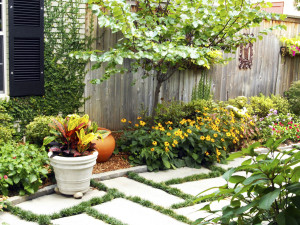
Small trees, like this redbud, are perfect patio companions. Vines soften the walls and fence, while a croton, black-eyed Susans, and other plants provide vivid color.
Annuals present the best choices since they’re colorful for months at a time. They’re good in beds and in patio pots and hanging baskets as well. Perennials, while beautiful, bloom only for a few weeks, so you will need to plan their use much more carefully. And with all of these plants, stick with types that stay between 4 and 8 or 12 inches tall so you won’t break that, say it together, class: “…line of sight.”
Fall is a great time to spruce up your patio plantings. To give you a few weeks to start the planning process, here are some of the plants that are most commonly used near Texas patios.
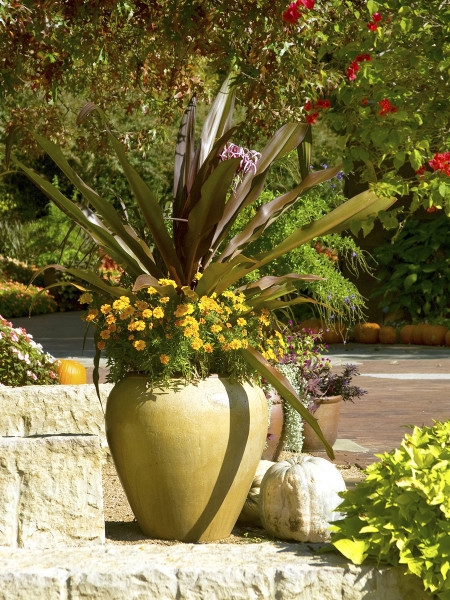
This patio pot has attitude! Just one eye-catching container can take an outdoor setting quickly from zero to 60.
Annuals
- Hybrid purslane
- Moss rose
- Fanflower
- Periwinkles (variety ‘Cora’)
- Pentas
- Trailing lantana *
- Ornamental sweet potatoes
- Pansies
- Pinks
- Wax begonias
- * Fallen flowers can litter.
Groundcovers
- Asian jasmine
- Purple wintercreeper
- Tam juniper
- Mondograss
- Sedums *
- Dwarf mondograss *
- Ajuga *
- * Limit plantings to smaller spaces
Low shrubs
- Harbour Dwarf nandina
- Harbor Belle nandina
- Flirt nandina
- Dwarf yaupon holly
- Carissa holly
- Wheeler’s dwarf pittosporum *
- Rosemary
- Germander
- * Winter-hardy to South Texas only
Small Shade Trees
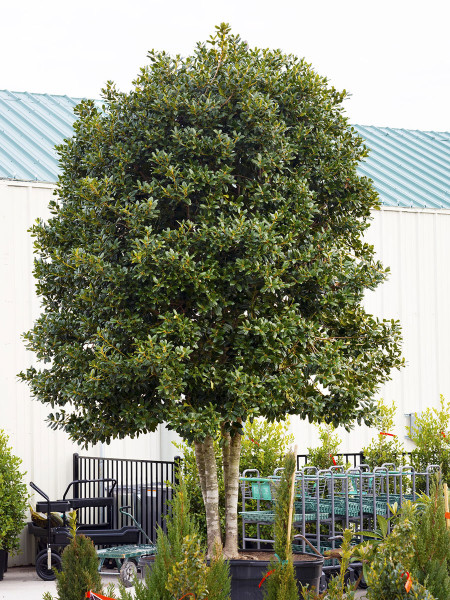
Tree-form Nellie R. Stevens hollies like this are somewhat uncommon in nurseries, but smaller sizes are increasingly available. (Photo from several months ago at Covington’s Nursery in Rowlett.)
- Nellie R. Stevens holly (tree-form)
- Yaupon holly (tree-form)
- Warren’s Red possumhaw holly
- Teddy Bear magnolia
- Golden raintree
- Redbud
- Mexican plum
Vines
- Carolina jessamine *
- Lady Banksia rose *
- Madame Galen trumpetcreeper
- Crossvine
- * Evergreen
Shrubs
- Nellie R. Stevens holly
- Willowleaf (aka Needlepoint) holly
- Oakland holly
- Mary Nell holly
- Texas mountain laurel
- Waxleaf ligustrum *
- Glossy abelia
- Elaeagnus
- * Do not use invasive Japanese ligustrum or privet.
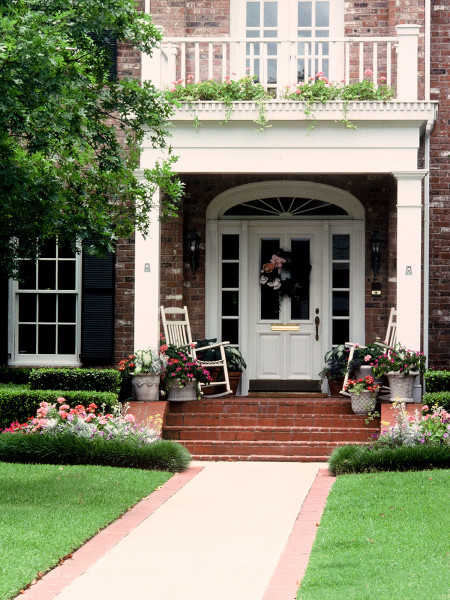
Coordinated rocking chairs and summertime containers create a relaxed welcome to a home that might otherwise seem very formal. Photo © Neil Sperry.
Your porch creates the first impression for visitors to your home. Most of us do not enter our own houses from the same point as guests do, so try this little experiment. Drive your car to the front of your house or into the driveway where visitors would park. Walk up to the door and take a critical look at your entrance. What greets your guests when they first approach? Are your front door and stoop or porch inviting and welcoming? What does the look say about you and your lifestyle? You certainly don’t want it to express “I’m boring and I don’t care about my appearance.”
Now that you have evaluated your porch or patio from a stranger’s point of view, it’s time to apply your personal style and taste in making it an extension of your home’s interior.
Consider your outdoor living spaces, porches and patios the way you do the inside of your house. They should be comfortable but attractive. They should invite you and your guests to sit down, relax, and stay for extended periods of time. Luckily, there are many products available today to choose from in furnishing and decorating outdoor spaces.

Step 1: Clean it up
Since we don’t usually enter our houses from the direction that guests enter, we may not notice that debris, cobwebs and wasps congregate there. So get out your broom and your ladder, and clean your porch from top to bottom. My front porch is open, so I can use a hose with a spray nozzle for this task. Don’t forget to wash your windows. You will want to enjoy the view of your newly spiffed-up porch from inside the house as well.
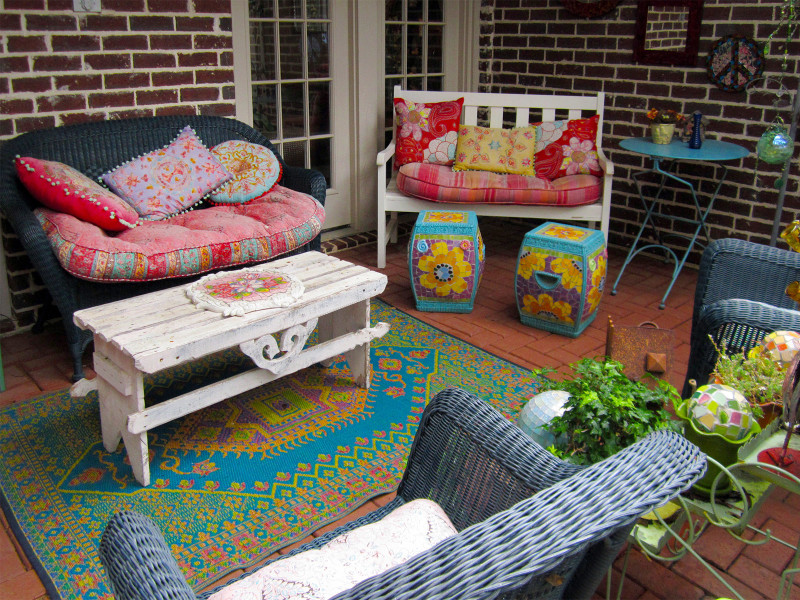
Central to the success of this arrangement is padded seating for quite a few folks, plus tables on which to place refreshments. Photo © Mary Wilhite.
Step 2: Coordinate your furniture

Even a small porch benefits from a chair and side table. To achieve a cohesive look, choose furniture pieces made of the same materials, or select a related style for all your pieces.
Cushions not only make your outdoor furniture more comfortable, they add a nice touch of color and texture. Several companies make pillows covered in sunproof and mildew-resistant fabric. An occasional run through the washing machine keeps them bright.
Outdoor rugs and welcome mats are widely available in a variety of styles and materials. They not only anchor the space but help prevent muddy footprints in the house.
Step 3: Accessorize
Accessorizing is how you can really add decorative touches, whimsy and a sense of personal style to your porch. Have a collection of shells from trips to the beach? Display them in a tray or a heavy glass jar on a table. Hang a mirror on the wall to create depth and break up the blank space.
Shade-loving plants for a porch or sun-loving plants for a patio make the space more appealing. On my shady porch I like to use tropical plants commonly sold as house plants: draceana, bromeliads, pothos ivy, royal palms and ferns. On my sunny patio I display hibiscus, citrus trees and mixed pots of annual flowers. I employ matching or coordinating colored, glazed pots for additional color.
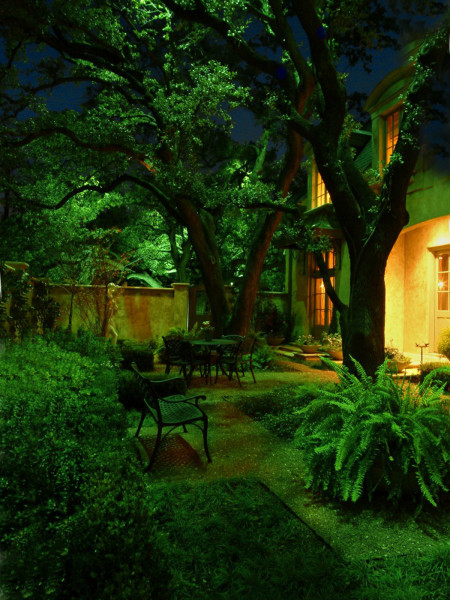
The drama of night lighting is inescapable. Nothing makes guests quite so welcome after dark. Photo © Lentz Landscape Lighting.
Step 4: Install special lighting or perhaps a fan
Hang a ceiling fan on your porch, or place a large, outdoor fan at the edge of your patio. Fans not only create a cooling breeze, they keep flying insects at bay. They can increase your enjoyment of the space immensely.
New outdoor lighting can change the ambience of your patio or entryway tremendously. Consider lights along pathways, beside architectural features, or even in trees.
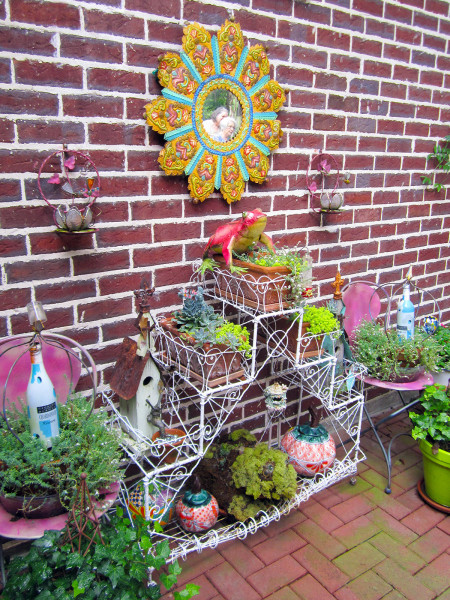
A whimsical plant stand, unique garden art, and chairs recycled to hold plants all work together to capture the personality of the owner. Photo © Mary Wilhite.
Step 5: Appeal to all the senses
Visual charm is the key to first impressions, but for continued enjoyment, stimulate all your senses in your outdoor space. Hang wind chimes close by, or install outdoor speakers to enjoy music. Place a tabletop fountain or other small fountain on the porch and be calmed by the sound of gently splashing water. Plant fragrant flowers around the outside of the porch or in pots so their scent wafts through the air. I like to have scented candles on my porch to create a pleasing scent and gentle light at night.
Do a makeover on your porch and enjoy the fruits of your labor with a new favorite spot to sip your morning coffee or evening glass of wine.
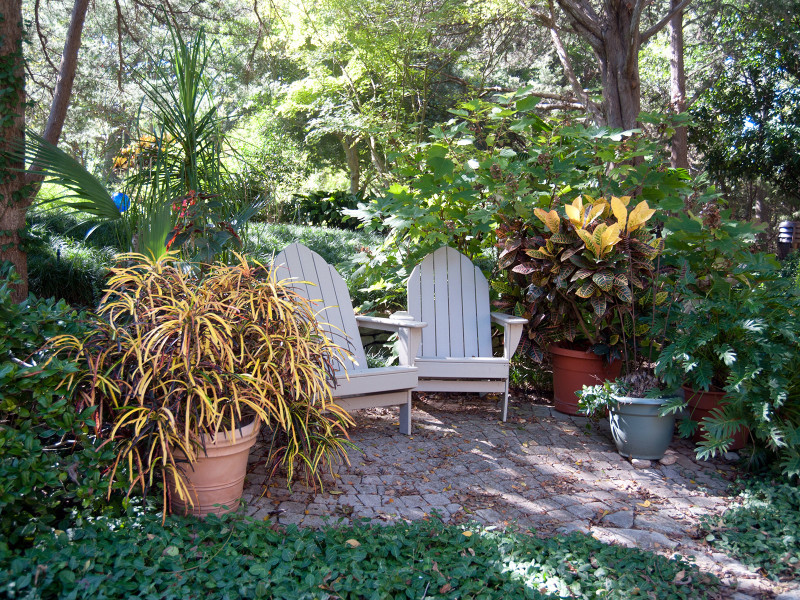
For Neil, a simple summer makeover for this small patio entails bringing out a couple of well-maintained garden chairs and a few tropical plants from the greenhouse. Photo © Neil Sperry.
What does a famous boulevard in Berlin have in common with beds of showy hibiscus right here in Texas? The boulevard Unter den Linden is lined with linden trees that are, like hibiscus, members of the Malvaceae family. This family contains more than 4,225 species of herbs, shrubs, and trees. Let’s take a look at six members of Malvaceae that lend ornamental value to the Texas garden.
Brazilian Rock Rose (Pavonia braziliensis)
This semi-woody shrub grows 3 feet tall and 3 feet wide in USDA Hardiness Zones 8a and south. It assumes a rambling growth habit and produces an abundance of small, white, hibiscus-like flowers with maroon centers May through October that attract butterflies. Brazilian rock rose prefers full to part sun and tolerates drought. It also reseeds easily. Prune, if desired, to keep compact.
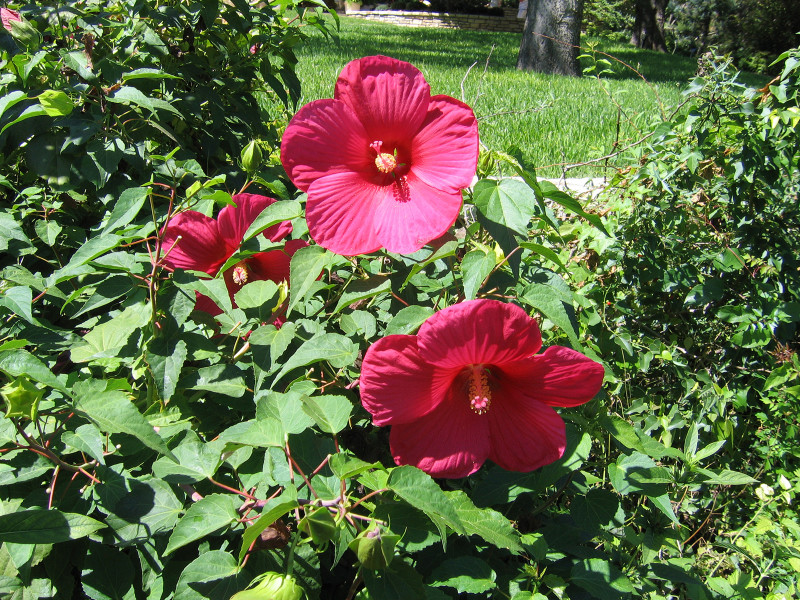
The huge blooms of hardy hibiscus can be show-stoppers in the summer garden. This one is Lord Baltimore.
Hardy Hibiscus (Hibiscus spp.)
Several species and cultivars of hardy hibiscus do well in Texas, including the native Hibiscus coccineus ‘Texas Star’, which has deeply lobed leaves and showy red flowers. Two hardy hibiscus that have made the Texas Superstar® list are Flare and Lord Baltimore. Flare sports large, showy, fuchsia-colored flowers that bloom summer until frost. The flowers are sterile, which means the plant is almost constantly in bloom because it directs all its energy to flower production and not seed production. Flare demonstrates hardiness to Zone 5, requires full sun, and grows 4 feet tall by 4 feet wide. Lord Baltimore is also cold hardy to Zone 5 and is an improved sterile hybrid with distinctively lobed leaves. It produces stunning red flowers summer until frost, grows 5 feet tall by 5 feet wide, and requires full sun.
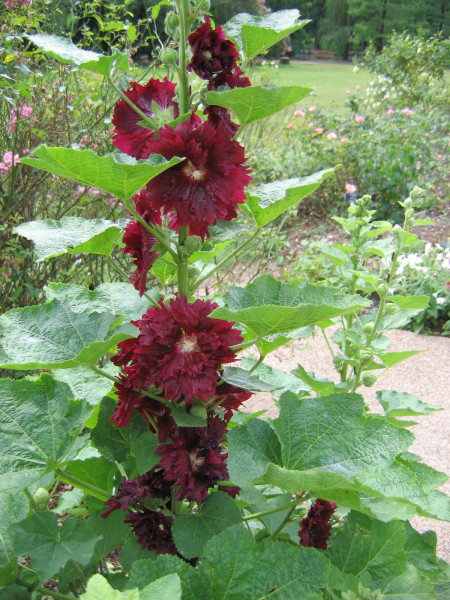
Hollyhocks frequently self-seed and return year after year. They come in countless colors and forms, with this double burgundy being less common.
Hollyhock (Alcea rosea)
Nothing adds more cottage-garden charm to a house than old-fashioned, single-flowering hollyhocks. These old garden favorites produce huge (4- to 5-inch-diameter), outward-facing, single flowers in a wide variety of colors, including reds, pinks, whites, and light yellows, on tall, rigid spikes that reach 5 to 8 feet tall and bloom spring through summer in full sun in all parts of Texas. The flowers attract hummingbirds and butterflies. Although considered a biennial or short-lived perennial, hollyhocks self-seed. The foliage is susceptible to a number of diseases, but the flowers are generally not affected.
Rock Rose (Pavonia lasiopetala)
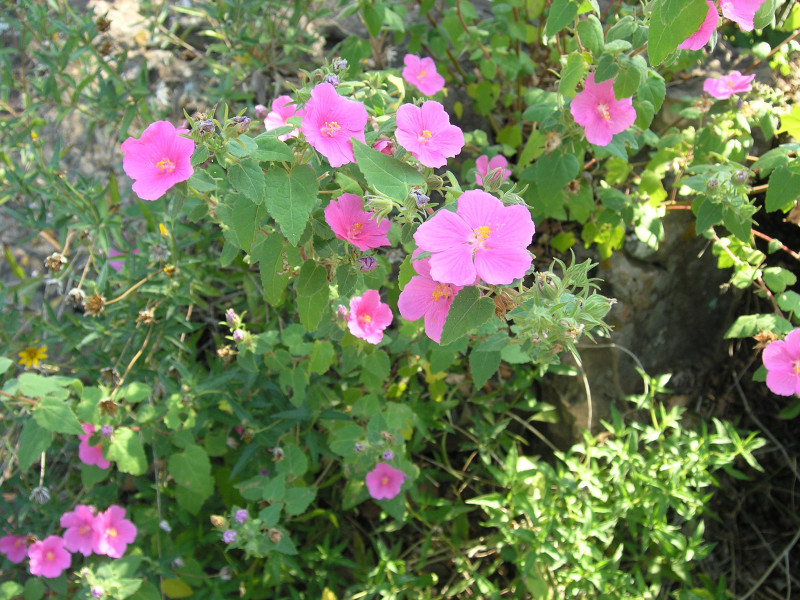
Rock rose is a small, woody shrub bearing an abundance of flowers attractive to butterflies and hummingbirds.

This Texas native forms a small shrub that is woody at the base and herbaceous on top and grows to a height of 3 to 4 feet and as wide. It grows in full to part sun and tolerates heat and drought. The satiny-pink, hibiscus-like flowers add color to any landscape, attract butterflies and hummingbirds, and bloom April to November.
Rose of Sharon (Hibiscus syriacus)
This native of India and China is a vigorous, upright, vase-shaped, multi-stemmed deciduous shrub that grows 8 to 12 feet tall and 6 to 10 feet wide in USDA Hardiness Zones 5 to 8 in full to part sun. It can grow as a large shrub or be trained as a small tree or espalier. Showy, hollyhock-like flowers up to 3 inches in diameter bloom June to October. Depending on the cultivar, flowers can be single or double, white, pink, or bluish-lavender. Plant this shrub in groups, singly as a specimen, or in a hedge or screen. It looks great in mixed borders with other shrubs, roses, and perennials.

Rose of Sharon has been a favorite in Texas gardens since pioneer days. They deserve wider use in today’s gardens. Photo © Neil Sperry.
Turk’s Cap (Malvaviscus arboreus var. drummondii)
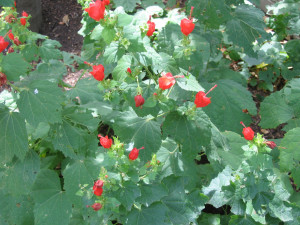
The unique red, fez-like blossoms of Turk’s cap earned this perennial its name. A few varieties bear white or pink blooms.
Another Texas native, Turk’s cap is a deciduous perennial that grows 2 to 4 feet tall and about 2 to 3 feet wide. In full sun, its leaves droop, but in shade, they are held more horizontally and make the plant look perkier. Turk’s cap gets its common name from its unique flower, which is a whorl of bright red petals that never fully opens and resembles a fez. The cultivar Big Momma has red flowers about a third larger than the species’ flowers. A pink-flowering cultivar named Pam Puryear is also available, as well as a white-flowering selection. Turk’s cap blooms from late spring until frost, and the flowers attract hummingbirds and butterflies. After the flowers disappear, marble-sized red fruits develop and appeal to the appetites of many different birds.
You don’t have to visit Berlin to see members of the Malvaceae family; you can grow six members of that family right here in your Texas garden. Plant them, and revel in the beauty of these marvelous members of Malvaceae!


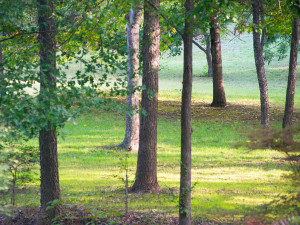
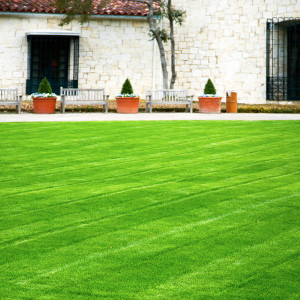
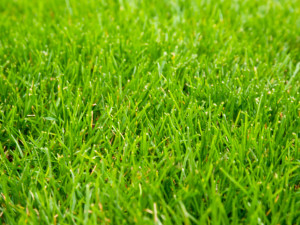 Ryegrass does not waste water! Some cities will make that contention and even forbid planting of rye, but the normal watering you give your lawn in winter will be sufficient for ryegrass. Even if you’re in an area with very stringent water curtailments, you can take the chance that the rye will get enough moisture to keep it going. The ryegrass you see in my home photos was watered the day it was planted in September 2014 and never again! Ryegrass does not waste water. Gardeners waste water! Banning ryegrass doesn’t suddenly make people wiser or more responsible.
Ryegrass does not waste water! Some cities will make that contention and even forbid planting of rye, but the normal watering you give your lawn in winter will be sufficient for ryegrass. Even if you’re in an area with very stringent water curtailments, you can take the chance that the rye will get enough moisture to keep it going. The ryegrass you see in my home photos was watered the day it was planted in September 2014 and never again! Ryegrass does not waste water. Gardeners waste water! Banning ryegrass doesn’t suddenly make people wiser or more responsible.

